



another taste by Frostbeard
December 6th, 2007 11:58 PMMy answer to the call of using a new spice has come in the form of something that is technically (although not certified) organic, can be used in slow food, vegan and veg cooking, and is very local. Yes, oh yes, hemlock.
While everyone thinks "Oh no! Hemlock was the state poison of Rome! It is super-poisonous!", they are referring to "real" hemlock, or the plant known as Cornium maculatum. Here, in the United States, what most people refer to as hemlock are trees of the Tsuga genus. In particular, in my Biome, it refers to Tsuga canadensis. This plant, and other coniferous trees are generally full of vitamin C, were used as a treatment of scurvy and impart a slight piny and citrus-like taste to food.
Feeling very rustic for the day i made a simple soup out of:
Chicken, sort-of-cubed
Shallot, diced
Mushrooms, Shiitake, diced
some salt and pepper
and of course, Hemlock (Tsuga canadensis leaves/needles
I cooked it until it seemed like it was done, and then consumed. It certainly wanted for overall flavor, but if i were really hungry and vitamin C deficient, i bet it would just be the bees' knees.
The Tsuga made the soup broth somewhat greenish, made it smell and therefore taste a little piny (which i think is a good thing), and added a citrus bite. I didn't eat the cooked stems and leaves, just tossed them out during the consumption process. I think it would be fine if one wanted to eat them, i just don't think one would get much nutritional value or pleasant experience out of chewing on boiled tree twigs.
Am thinking i'll cook with conifers again.
Tsuga what?
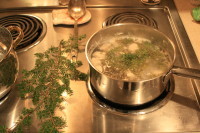
Ya. Tsuga this! Branch of said tree and pot of boiling chicken and other stuff with Canadian Hemlock in it.
The broth
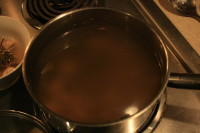
The broth is greenish from the process. You can see some shadowy leaves still in there. The whitish murky parts are chicken under there. I ate some more for a sort of second dinner after meeting a friend for beer. So, it must be good, right?
21 vote(s)

Spidere
5
Lincøln
5
teucer
5
Sean Mahan
5
anna one
5
Fonne Tayne
5
Levitating Potato
5
susy derkins
5
r0ck c4ndy
5
rongo rongo
5
Charlie Fish
5
Herbie Hatman
5
Meta tron
5
Iaman
5
Blue
5
Stu
5
Flitworth
5
Bex.
5
Ben Yamiin
5
High Countess Emily
5
Icarus
Terms
(none yet)14 comment(s)
This doesn't seem like the ideal season for hemlock, to me.
In spring the newly-grown needles, which are a pale green color, have a kinda sweet taste, reminiscent of rosemary. As the leaves darken with age in the early summer, they get a bit bitter, so you can't really use nearly as much.
(Anyway, hooray for hemlock.)
Ya, that's true. I suppose i should've mentioned that. It is pretty much the case with the leaves of any plant...the younger ones have less tannins, different amounts of various other chemicals, and are just more pliable and nice to consume. So, thanks for pointing that out. I had just been interested recently in what consumable items there were around here in the winter, that hardest time to find food, so decided to experiment with that. I definitely plan on giving it another go when i can get some spring needles.
Way to go incorporating something unusual yet ubiquitous. Tasting your daily world!
You get my vote simply for the fact that you can now brag that you have ingested hemlock and lived to tell the tale.
ya i know. i should find all sorts of culturally misappropriated terms and use them to my advantage! thanks for the support.
"okay" hemlock and "not okay" hemlock are pretty easily distinguishable from each other, from what I remember of nature camp--that said, I hope anyone looking to recreate this does their research first. Nice completion.
hey thanks. Ya, the "hemlock" over here is a big evergreen tree. The deadly poison hemlock is some weedlike plant thing. it's not exactly like trying to tell poisonous from non-poisonous mushrooms or anything (a skill i constantly loathe myself for not having).
Yeah, it's a lot closer to trying to tell oak and poison oak apart.
The bush is a poison. The tree is edible year round, but only the spring needles are actually worth eating, IMO.
Out of curiosity, where are you based? Got access to sourwood? I used to go backpacking and keep a sourwood leaf or three in my water bottles to hide the iodine flavor.
Unless I'm mistaken, the two varieties of hemlock share a name because of similar smells, but no similarity beyond that.
How did poison oak get that name, anyway? Just the similar leaves?
I used to know more about edible plants, but the most recent thing I've picked wild and eaten was blackberries that got added to pancakes. An awful lot of stuff has at least nominal nutritional content.
The last wild plant I used for anything was birch. A roommate and I tried to make birch beer; it ended up tasting like a wintergreen soda - which is almost right, but off in significant ways.
This is awesome! It makes me wonder what in my environment I could be eating. (I don't actually know enough to begin answering that question, but at the very least, this is a good reminder to use the leftover sage I've been staring quizically at since Thanksgiving.)
ya well, if you don't live on land that used to be used for leather tanning or something then you should def. check it out. sometimes places will run courses on this kind of thing (esp. check out university outdoor clubs) but there are also books, and of course, everything exists on the internet.














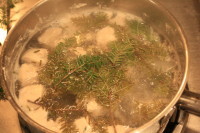
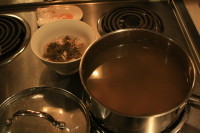
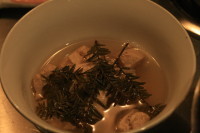
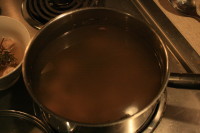








This is something I must try. Research and double check first (poisoning oneself is bad), but then try.